Cold Chain Logistics: Management Challenges & Solutions
The supply chain is a term used to describe all the components required to transport goods from beginning to end, from production to the end...
10 min read
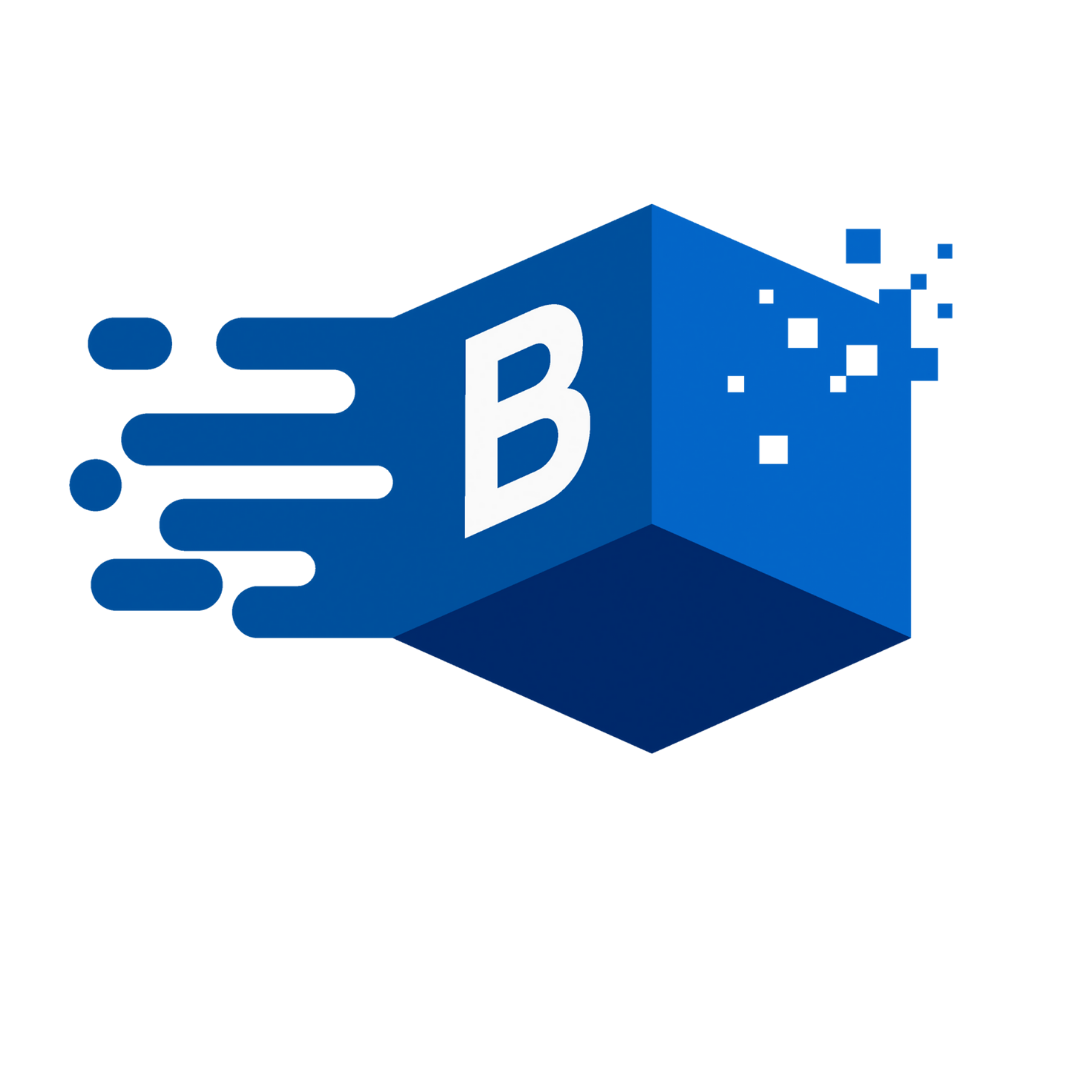 BUKU Marketing
:
Feb 22, 2023 1:36:05 PM
BUKU Marketing
:
Feb 22, 2023 1:36:05 PM
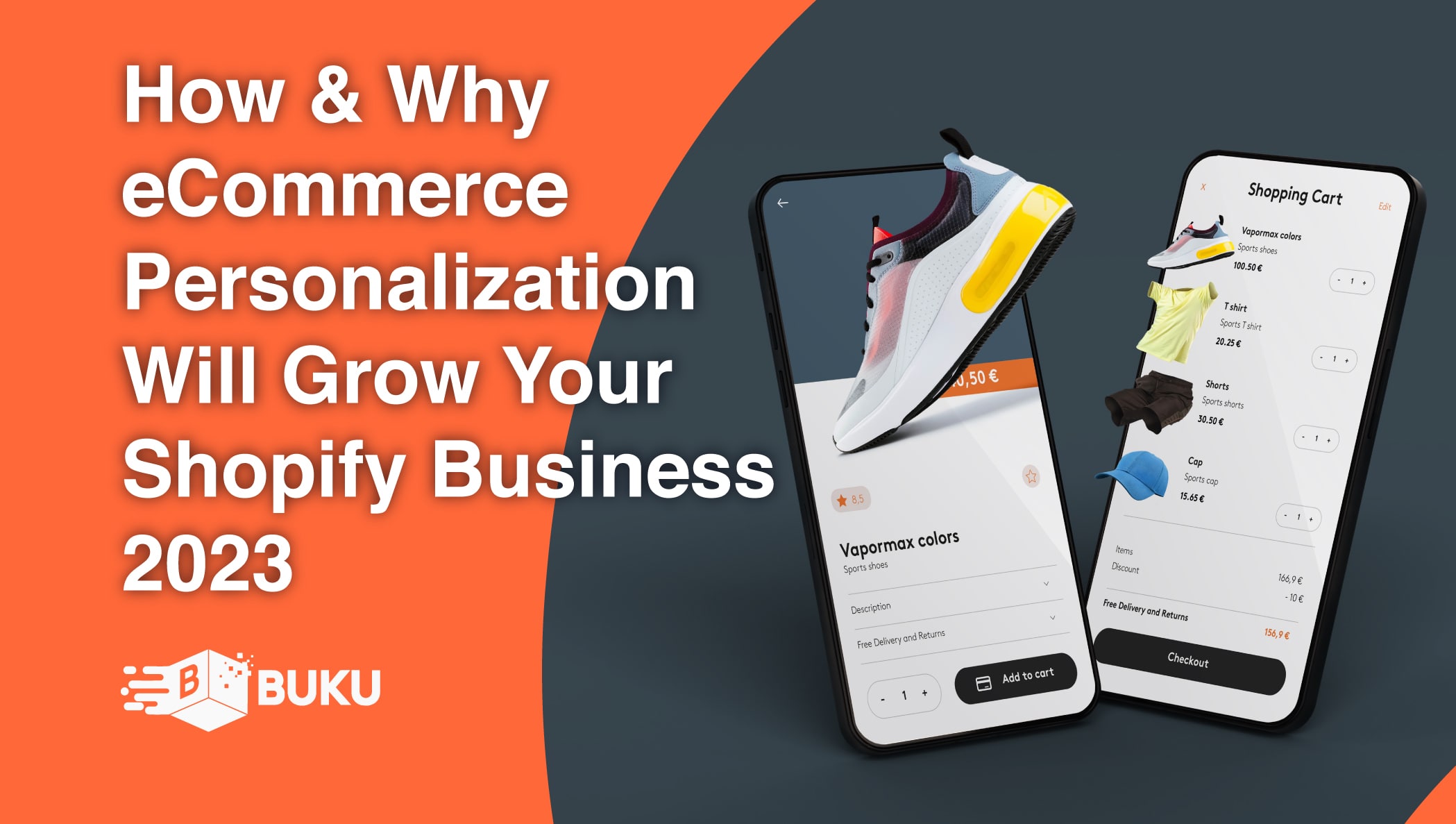
Ecommerce businesses are always looking for ways to get ahead of the competition. There are many ways that you can further your business and increase your brands growth.
Table of Contents
1. Why Is Personalization Important In Ecommerce?
2. The Differences Between Ecommerce Personalization And Customization
3. What Are The Benefits Of Ecommerce Personalization?
4. Get Started Personalizing Your Ecommerce Store
5. What Are Some Effective Strategies For Better Ecommerce Personalization?
6. The Differences Between B2B And B2C Personalization
7. Ecommerce Personalization Examples
8. How Personalization Completes The Customer Experience
Offering shoppers, an experience they can’t find anywhere else is vital to keeping them returning. Personalization is a tool that eCommerce businesses are using to do just that.
Personalization is a process that eCommerce stores use to create individualized, personalized experiences for their customers. This is often referred to as “dynamic” marketing.
Businesses can use a plethora of data to help them create a truly personalized interaction with each customer, such as their purchase history, demographics, language, behavior, and much more.
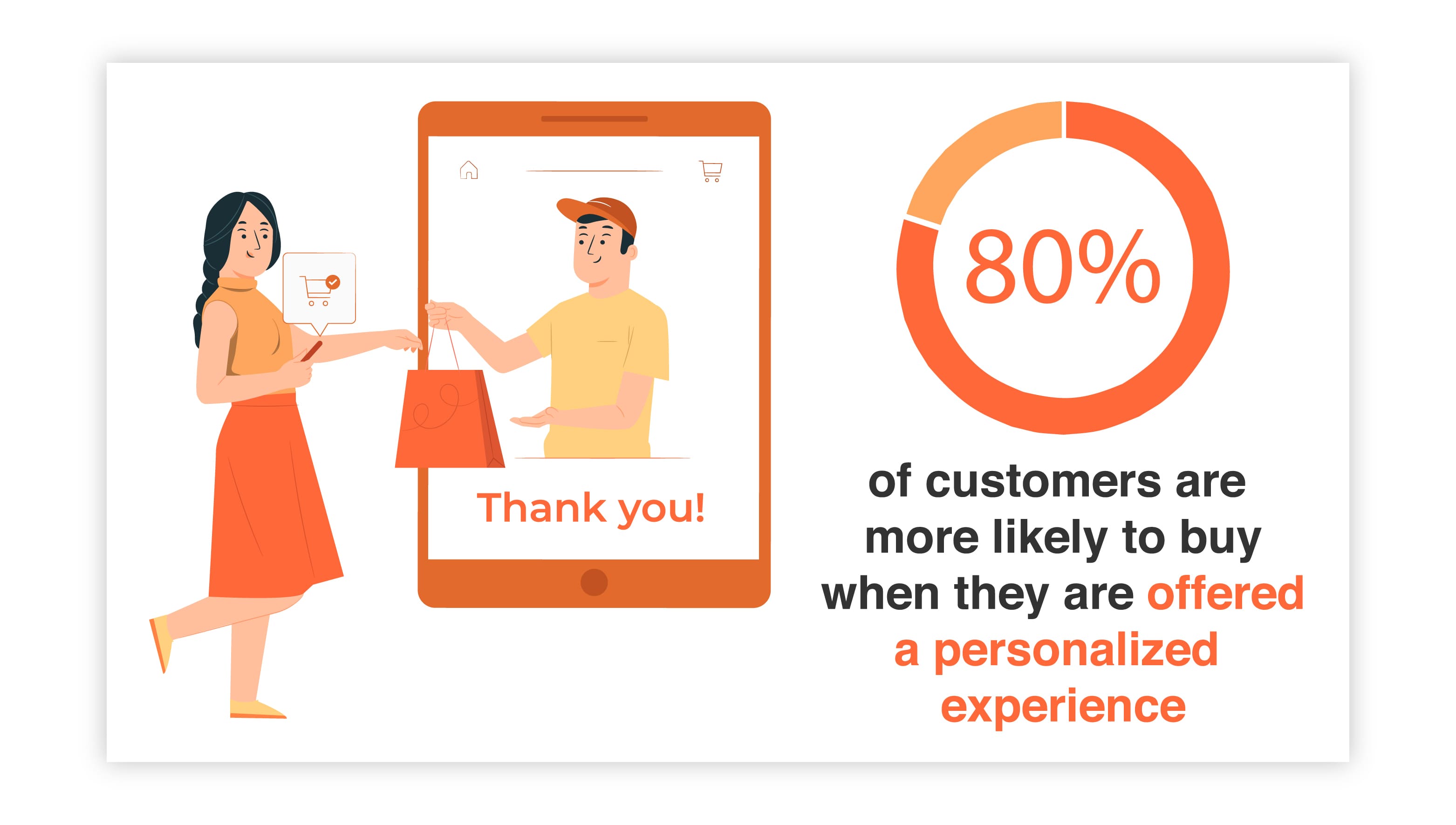
Is personalization really that important to your customers?
Absolutely. 80% of customers are more likely to buy when offered a personalized experience. On the other hand, nearly the same percentage of customers say that a lack of personalization would deter them from purchasing. If you’re not working to offer personalized dynamic content for your customers, you’re handing them over to the competition.
In this article, we discuss the basics of eCommerce personalization - what it is and why it’s so important. We will show you how to get started collecting the data you need to do it right and offer some effective strategies to personalize your customers' experiences starting today.
Your customers are bombarded with options regarding where they can shop online. Large retailers like Amazon already dominate the market. Why? Because they offer competitive pricing – and offer shoppers a personalized experience.
Amazon remembers the products shoppers have viewed before and knows their previous purchases. Amazon knows where they live, how much they spend on average, and what browser or device they use to access the site,
Amazon uses all this information to make product recommendations that are most likely to result in a purchase and cater the shopping experience to each customer.
It’s already hard to compete with large online retailers in the eCommerce market. But including personalization tactics on your site is one way to do it. Your customers have grown accustomed to receiving personalized experiences online, and they are more likely to visit and purchase from stores offering those experiences.
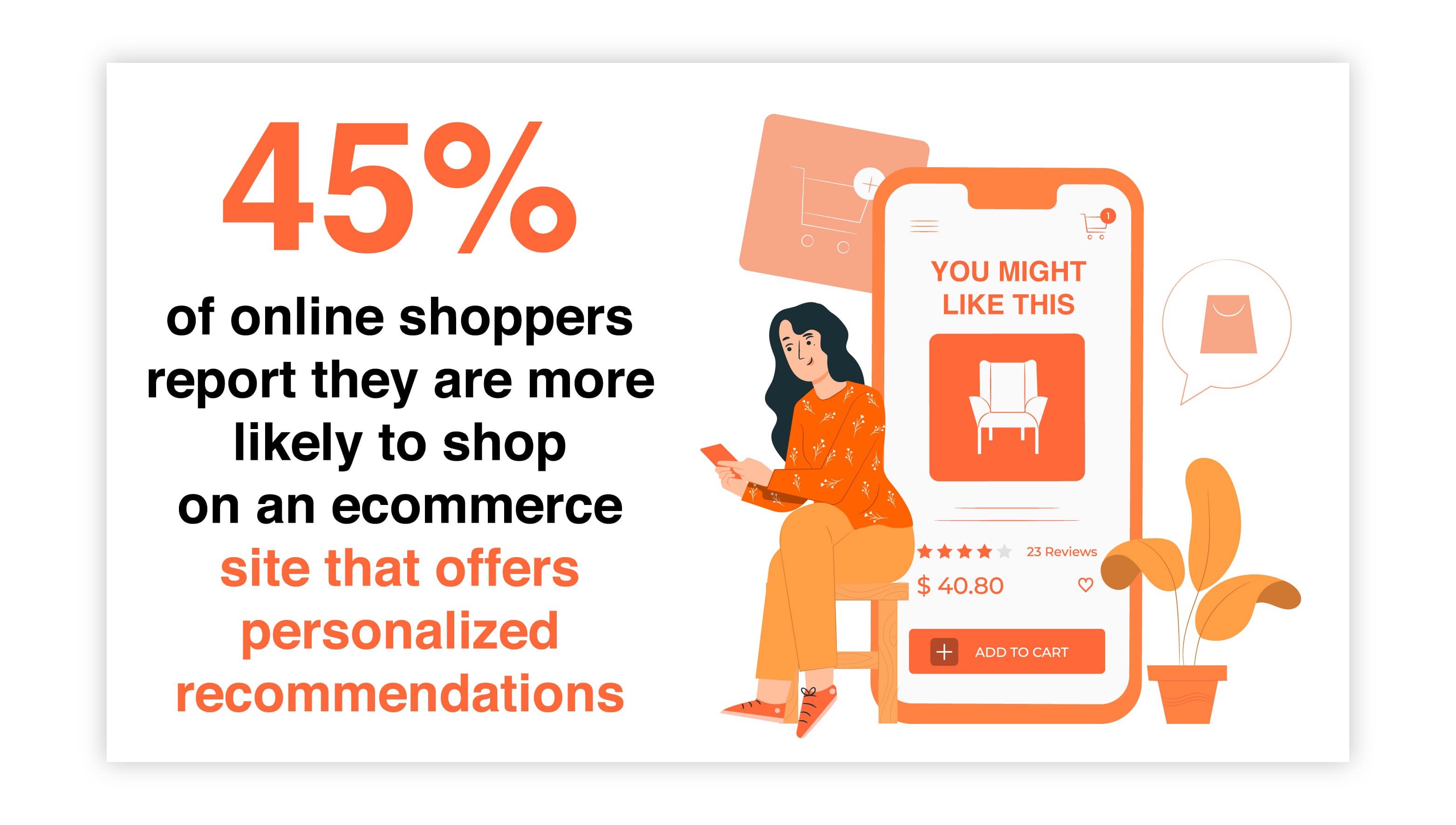
45% of online shoppers report they are more likely to shop on an eCommerce site that offers personalized recommendations. Your customers want eCommerce personalization and are willing to share their data with you if it means getting that experience. Not only that, but they are also more than willing to jump to a competitor’s site if you’re not offering those kinds of experiences.
You may have heard both the terms eCommerce personalization and customization before. These terms describe how experiences are individualized to fit a shopper’s interests. The difference is how these things are implemented and who initiates the changes.

Personalization – When a business personalizes a customer's shopping experience, they take specific actions based on data collected about that shopper. It refers to actions taken by the business to benefit the customer. You, as the eCommerce store owner, take steps to personalize the experience for your customers.
Customization – Customization is also an action taken to create an individualized experience for the customer. The difference is that, in this case, the customer acts - not the business owner. The customer decides what kinds of automation they experience and what recommendations they see. They decide whether to receive emails from a brand or text messaging sent straight to their mobile device. That’s customization in a nutshell.
Ecommerce personalization can have a dramatic impact on the success of your business. When it comes to the customer side, personalization touches nearly every performance indicator on the list: improved experiences, increased traffic, more sales, and greater revenue. If you’re looking to improve your KPIs concerning customer satisfaction and sales, personalization is a great way to do so.
We’ve listed some of the biggest benefits of eCommerce personalization below.

Customers who receive an individualized experience when visiting your eCommerce site are more likely to visit frequently and spend more time engaging with your store. Companies are often willing to spend a large percentage of their advertising budget to drive traffic and engagement on their site – personalization offers those same results for free.
One of the greatest benefits of personalization comes from bundle orders. When a customer purchases something from your site, you can use that information to suggest similar items. Amazon effectively does this with its "buy it with" section and suggests related items.
The chances of your customers adding items to their cart are much higher when those items are based on their past purchases and browsing history. Want proof? Marketers report an average 20% increase in sales after introducing personalization into their strategy.
Offering a personalized experience to your customers can increase overall conversions and revenue. Personalization allows you to cater to your customers' interests and help them along their sales journey.
For example, you can remind customers who abandon a cart by suggesting they return and complete their purchase. You can send personalized email and text messaging offers based on their browsing and purchase history. It’s all about giving your customers exactly what they want when they want it.
Customer loyalty is essential for a successful business. The cost of attracting and converting new customers is exponentially higher than persuading past customers to return for additional purchases.
56% of online shoppers are more likely to revisit a website if offered personalized product recommendations. Personalization is a great way to build a strong, loyal customer base that will continue to pay dividends in the future.
If you’re talking about the benefits of personalization, an improved customer experience tops the list. Every other benefit on this list is directly affected by your customer's experience.
A negative experience is devastating to an eCommerce business. Creating positive experiences will keep customers returning, increase positive reviews, and cultivate customer loyalty.
Creating an eCommerce personalization strategy starts with collecting relevant data. The information gleaned from your customers – directly or indirectly – allows you to offer them an individualized experience.
But how do you get that data? Well, your customers are already offering a lot of it for free. You just need to know how to collect it. Some eCommerce platforms will display this data for you; some of it you must go out and gather yourself.
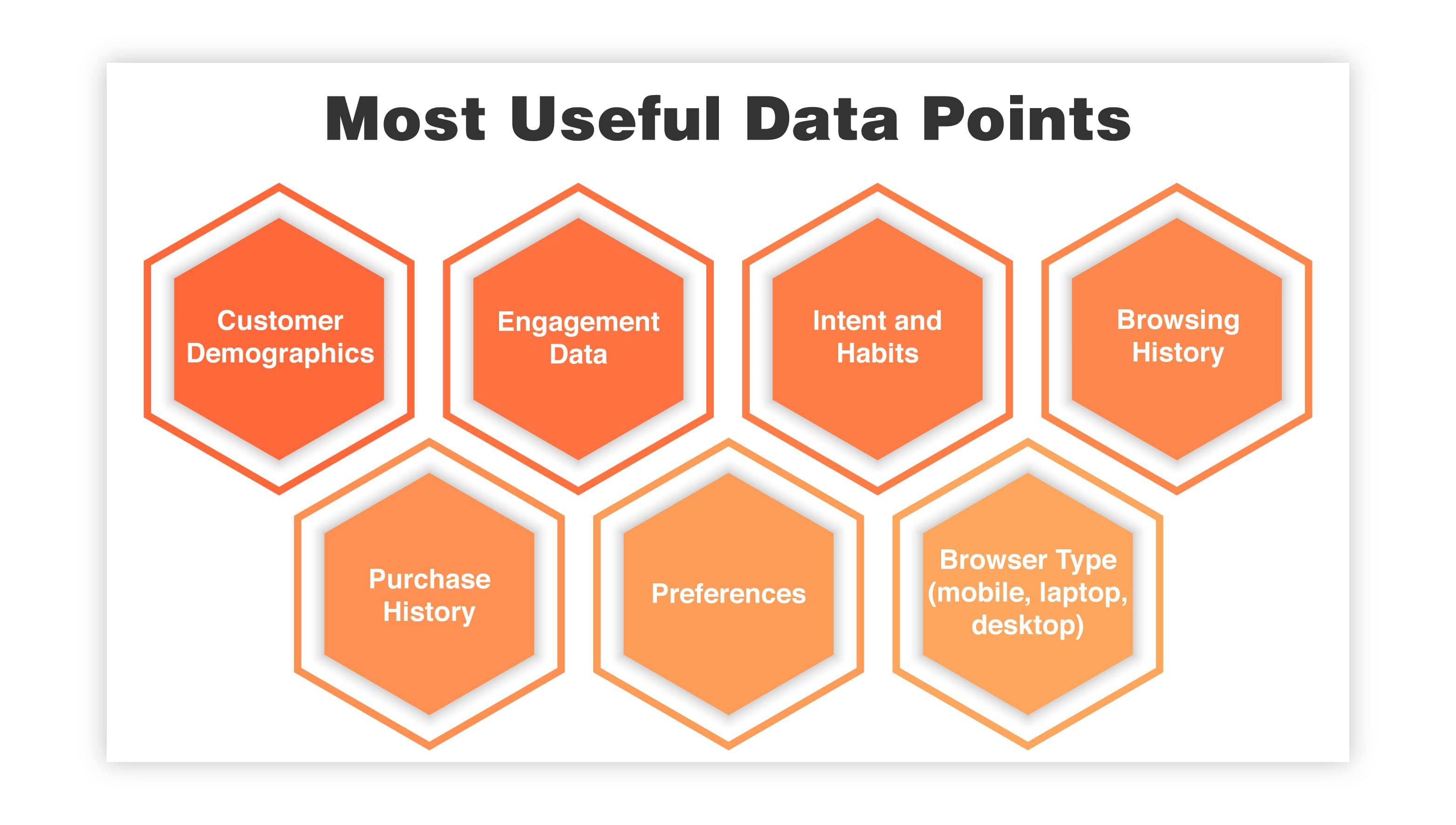
A few of the most useful data points include:
Another powerful tool for websites is “cookies.” You’re probably familiar with cookies by now if only because virtually every website you visit online offers you the choice of accepting or denying these cookies. But what are they?
Cookies are also called HTTP cookies or browser cookies, and they are essentially small files stored on a user's browser. These cookies can be helpful for your customers because they can remember login information, payment details, and shipping information.
But they’re also useful for eCommerce stores because they remember tons more details about your customers and their actions while on your site.
You can use this plethora of information to personalize every interaction between you and your customers, not just while they’re on your site. You can personalize your marketing strategy, email, SMS, and social media advertising.
There are so many ways that you can implement eCommerce personalization to improve your customer experience. We’ve listed some of the most effective below.
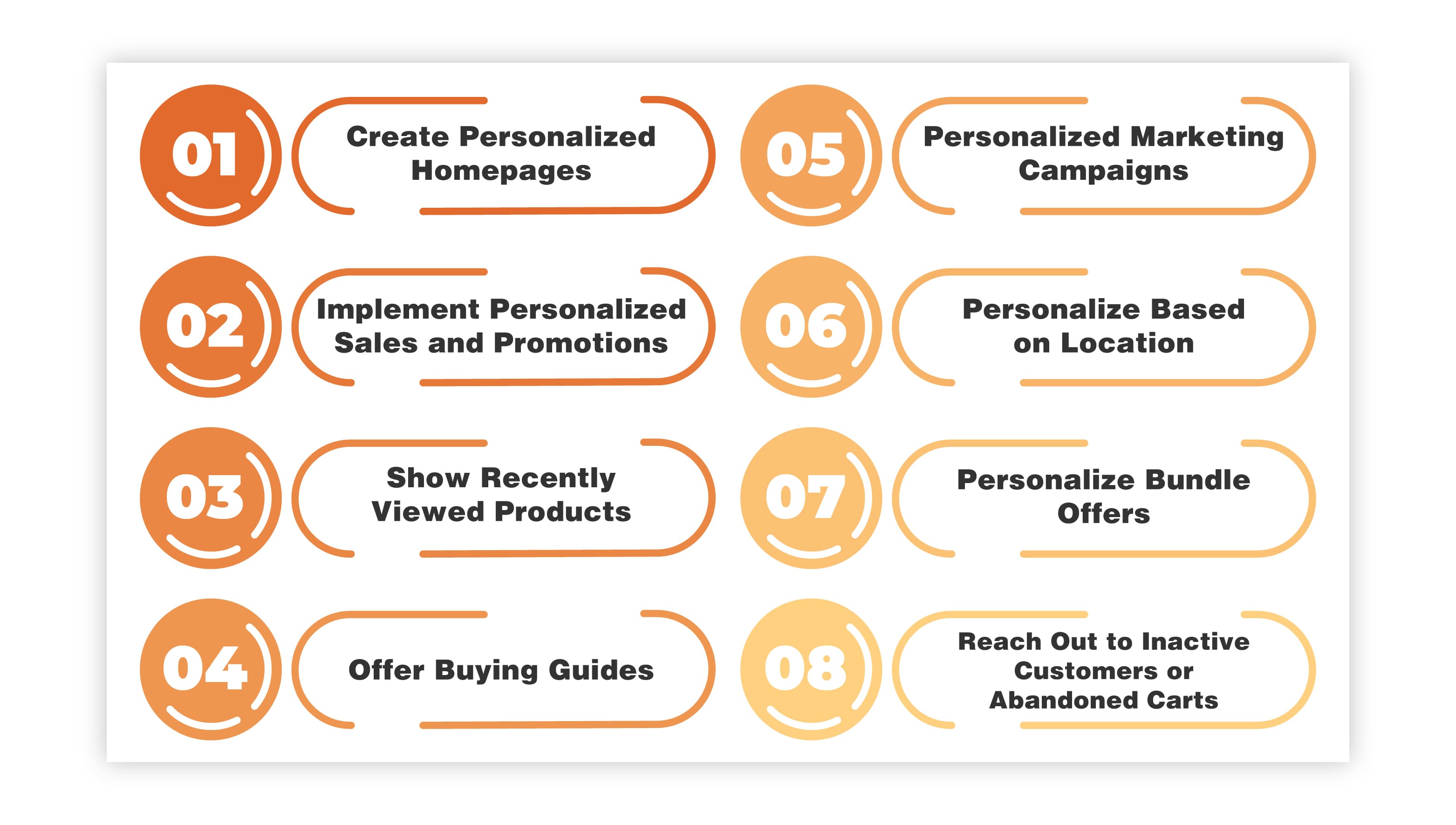
The homepage is an excellent way to personalize a visitor's experience. The first time a customer visits your site, they will probably be greeted by a universal homepage. They will take some action on the site, browsing specific categories, using the search bar to look for a specific product, and hopefully making a purchase.
You can use that information to personalize the homepage they see the next time they return to your store by prominently displaying the categories and products you know they are interested in. This makes it easier and faster for them to find what they’re looking for and increases their chances of purchasing.
Everyone loves a great deal, and your customers look for that online. You can use data about their activities on your site to create personalized offers and promotions. You can use these offers to gather even more information about your customers.
You would be surprised how much information your customers will give up in exchange for a discount. You can use personalized messages and pop-ups on your site that are designed to match the behaviors and intent of your customers, like offering first-time visitors a discount in exchange for their email addresses.
Take advantage of the knowledge you’ve already gathered about a customer by displaying the products they’ve already looked at. That way, if they’ve returned to buy something they were previously hesitant about, you have removed any roadblocks for them and helped them get right back where they left off.
Because you already know what your customers are interested in shopping for, you can create personalized buying guides filled with products that might interest them. You can base this guide on their previous browsing behavior, or you can ask your customers for their preferences directly. Buying guides also make perfect sense if you’re using email or SMS marketing (and you should be).
Speaking of email marketing – if you’re using this strategy and not personalizing your messaging, you’re doing yourself and your business a disservice. Email marketing is one of the most successful and cost-effective channels for customer engagement.
Email marketing generates an average return on your investment of $38 for every dollar invested. And personalizing your email messaging through segmenting your customer list, creating personalized subject lines, and targeting your copy specifically to your customers greatly improves the success rate of your campaign.
If you can gather information about the location of your customers, you can personalize their shopping experience to match. Different countries use different languages and currencies. They have different sizing charts and even different climates. And you can personalize their shipping selections based on their location and offer dynamic pricing so that they can see real-time shipping costs.
Those moments before your customer finalizes a purchase are extremely valuable. Take advantage of them by offering shoppers additional product recommendations that complement their purchase. Sweeten the deal by offering a discount on shipping for customers whose purchase value meets a certain threshold.
When a customer abandons a cart on your site, it provides a must-grab opportunity for you as the business owner. You already know which products they were considering, making it easy to reach out to them one last time before they click away or via their inbox, after they’re gone.
And if you have a customer who hasn’t visited or purchased from you in some time, you can personalize a message asking them to come back and maybe throw a discount offer in there for good measure.
Ecommerce personalization has a lot to do with the customers themselves. You can’t personalize an experience without considering who your customer is and what they need. One important factor to consider when creating a personalization strategy is whether you’re a B2B or B2C business.
B2B – Business-to-business selling means selling your products or services to a business entity.
B2C – Business-to-Customer, or consumer, means you are selling directly to single online consumers.
You can use personalization tactics for both types of selling. However, to be the most successful, it’s helpful to understand the difference between these two types of customers.
Business-to-Customer selling is centered around need, emotion, and impulse. Customers generally know exactly what they’re looking for when they enter your site. Their need for a particular item drives them or because they “want” a particular item. They’re in charge of their pocketbook. They make their own decisions.
Business to Business selling is different because the person shopping represents a larger entity. They usually have superiors and executives to answer to, so they are much more cautious and analytical when making purchases.
They are going to weigh up the pros and cons very closely. The benefits they seek are related to the business itself, not the person browsing your site.
Knowing this, you might wonder if offering B2B customers a personalized experience will make any difference.
And the answer is yes.
Your B2B customers will appreciate personalized offers and recommendations because it saves them time – and in business, time is money. You’re also helping them make informed decisions, giving them a greater reason to buy from you.
Get creative and start building your eCommerce personalization strategy. You can borrow proven strategies, but you can also think outside the box and create something unique. Here are a few examples of personalization strategies to get you started.
One of the most effective ways to improve your customer experience and generate more sales is to "suggestive sell." Brick-and-mortar stores always do this, either through targeted displays and promotions or directly at the checkout counter. You can do it digitally by displaying a list of products your customer might be interested in based on their previously viewed pages, categories, and products or based on previous purchases.
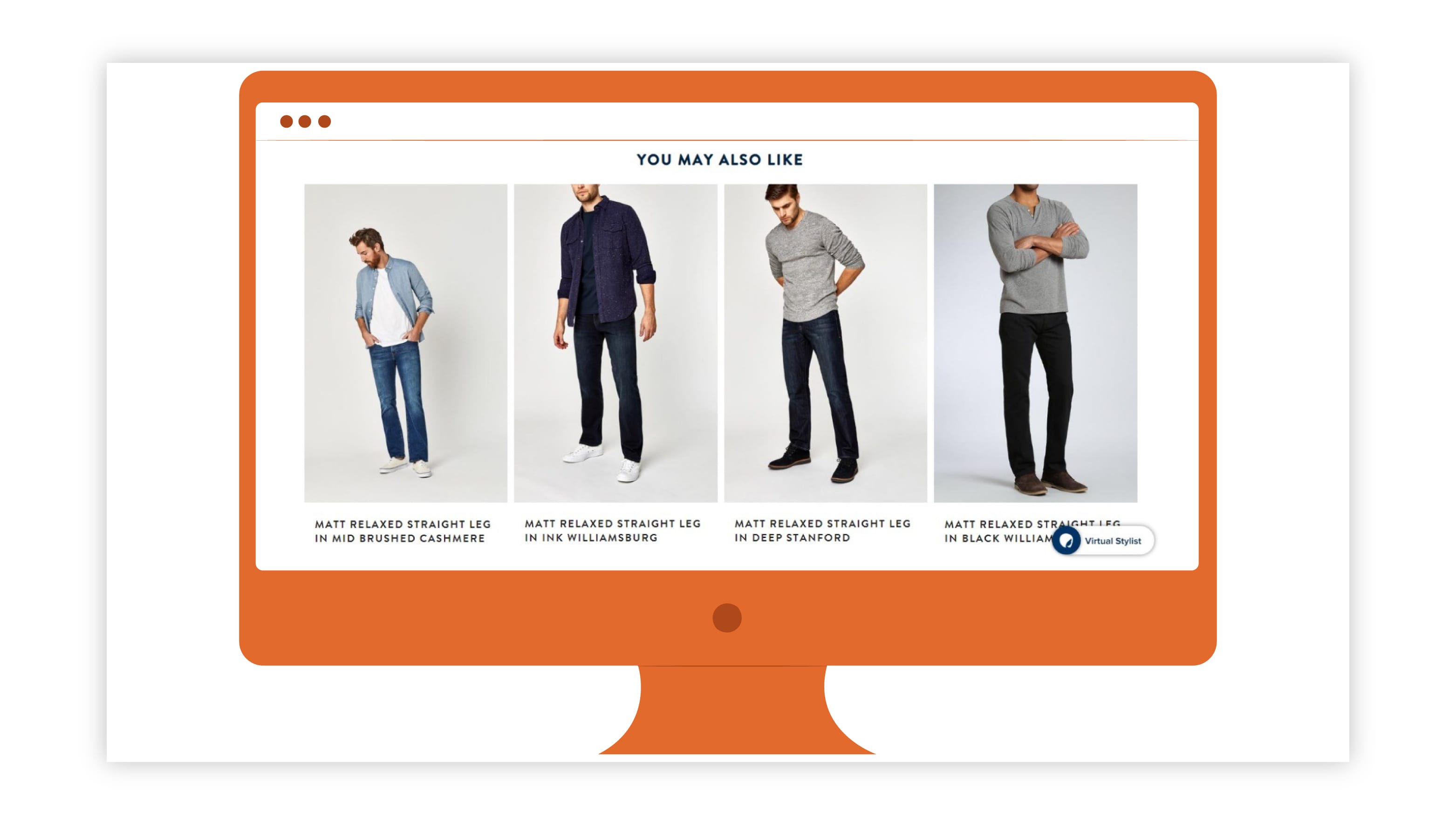
Customizable products offer customers a way to personalize their own shopping experience. And it’s a great way to drive business. You can partner with a third-party company to print customized stickers, decals, and other customizable gifts and let customers choose their message or design. Even offering customers the ability to include a personalized gift message with a purchase gives them an extra reason to buy.
To add an extra selling point to your personalized recommendations, create a best-seller list to display for your customers. Shoppers love knowing that their products are top sellers because it adds confidence to their buying experience. Remember that your customers trust each other more than they trust you.
Speaking of the above-mentioned trust that customers have in each other, you can display user-generated content on your site to keep both past customers and new site visitors happy. User-generated content includes images and videos of past customers using your products in real-life.
Let them model your apparel or capture themselves using the products they purchased, and then display these on your site for customers to see. Or just ask them to leave a review of a product that you can display for shoppers to read.
We might hate them when browsing the internet, but websites use pop-ups because they work. This is especially true for eCommerce stores because you can personalize those pop-ups to match your customers' behaviors and persuade them to take a specific action.
Ask them to subscribe to your email list for special offers. Inform them of new products or upcoming promotions. Remind them to follow through with a purchase. The possibilities are endless.
Ecommerce personalization allows online retailers to do something they previously did not have access to – interact with their customers.
Imagine you’re shopping in a record store and looking for a specific album to purchase as a gift for your father – the Complete Billie Holiday box set. You might start by browsing through the jazz section. You might need to narrow your search by looking specifically for female jazz singers. If you don’t find it there, you might check out the section where all the box sets are located.
Still no luck? Well, you can always ask a salesperson for help. And if they don’t have what you’re looking for, that salesperson can make recommendations to help you find something you might like.
For some, these experiences make in-person shopping easier, faster, and more enjoyable. But online shopping has come a long way.
Now customers can use the search bar to locate a specific product. They can browse through categories. And they can receive personalized product recommendations based on those actions every time they visit your store.
Personalization methods make your customers feel more valued and more like real people instead of another number. They feel like they’re a part of the experience. They feel like you, as the business owner, care about what they want, what they need, and what they’re doing.
Providing your customers with a personalized experience helps them feel seen and heard, and those customers will reward you with more sales, positive reviews, and with their loyalty.
Online shopping has evolved over the years, and to keep up with the changing times, you will need to evolve your strategies as well. No longer can online retailers neglect eCommerce personalization strategies and hope for the best. Remember, your competition online is stiff, and chances are very high that those competitors are using personalization methods already.
Creating a positive customer experience is one of the most important things you can do as a retailer – if you want to be successful, that is. Your customers pay the bills. Without them, you’re just paying to display pretty products. That’s a strategy that is simply not sustainable.
Create a personalized experience for your customers across the board and in every interaction – on your site, in their inbox, and on social media – and you will see the benefits in increased sales, greater conversions, higher revenue, and greater success.

The supply chain is a term used to describe all the components required to transport goods from beginning to end, from production to the end...
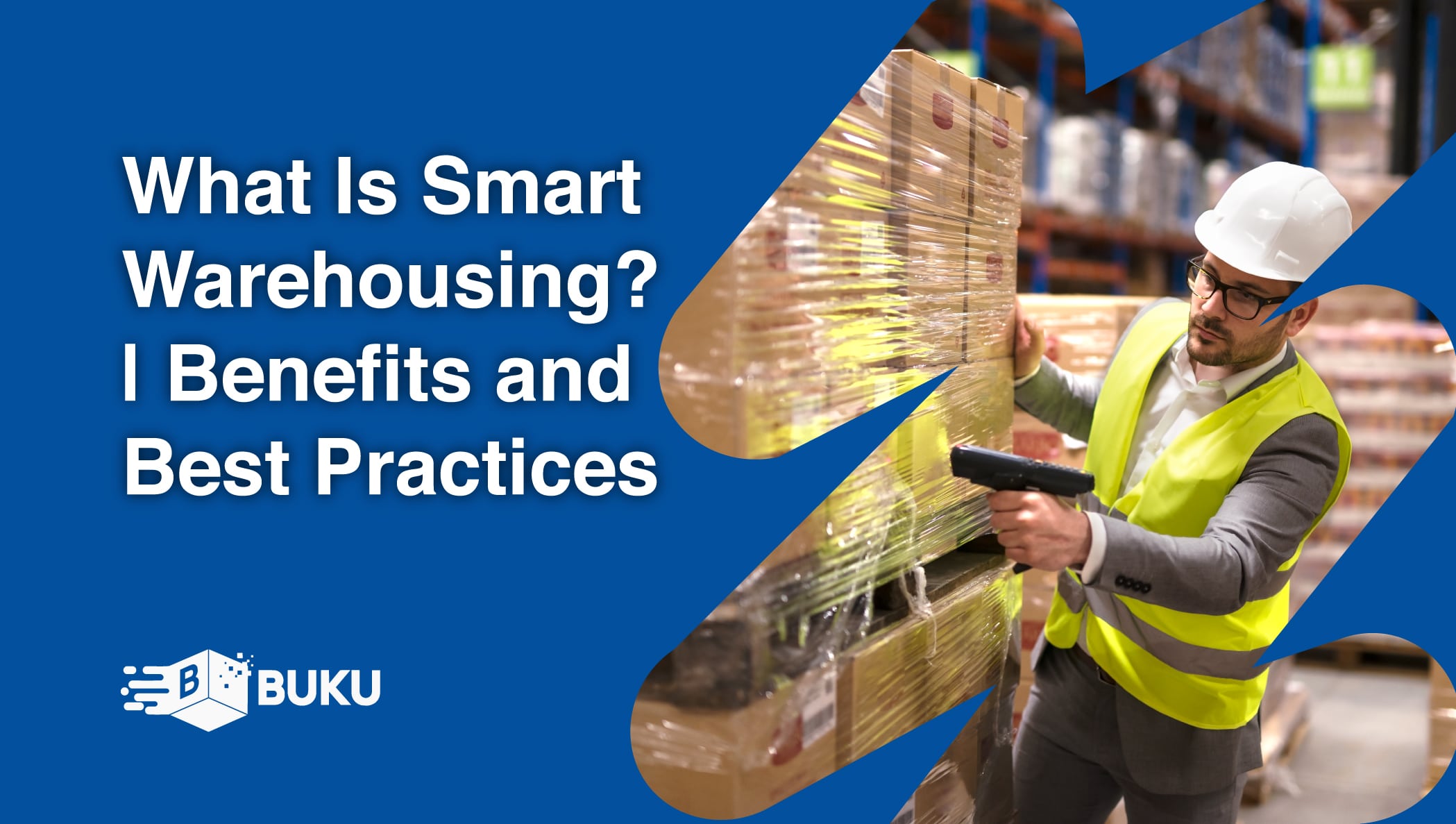
A smart warehouse is a large building where raw materials and other consumer goods are stored using machines, computers, comprehensive software, and...
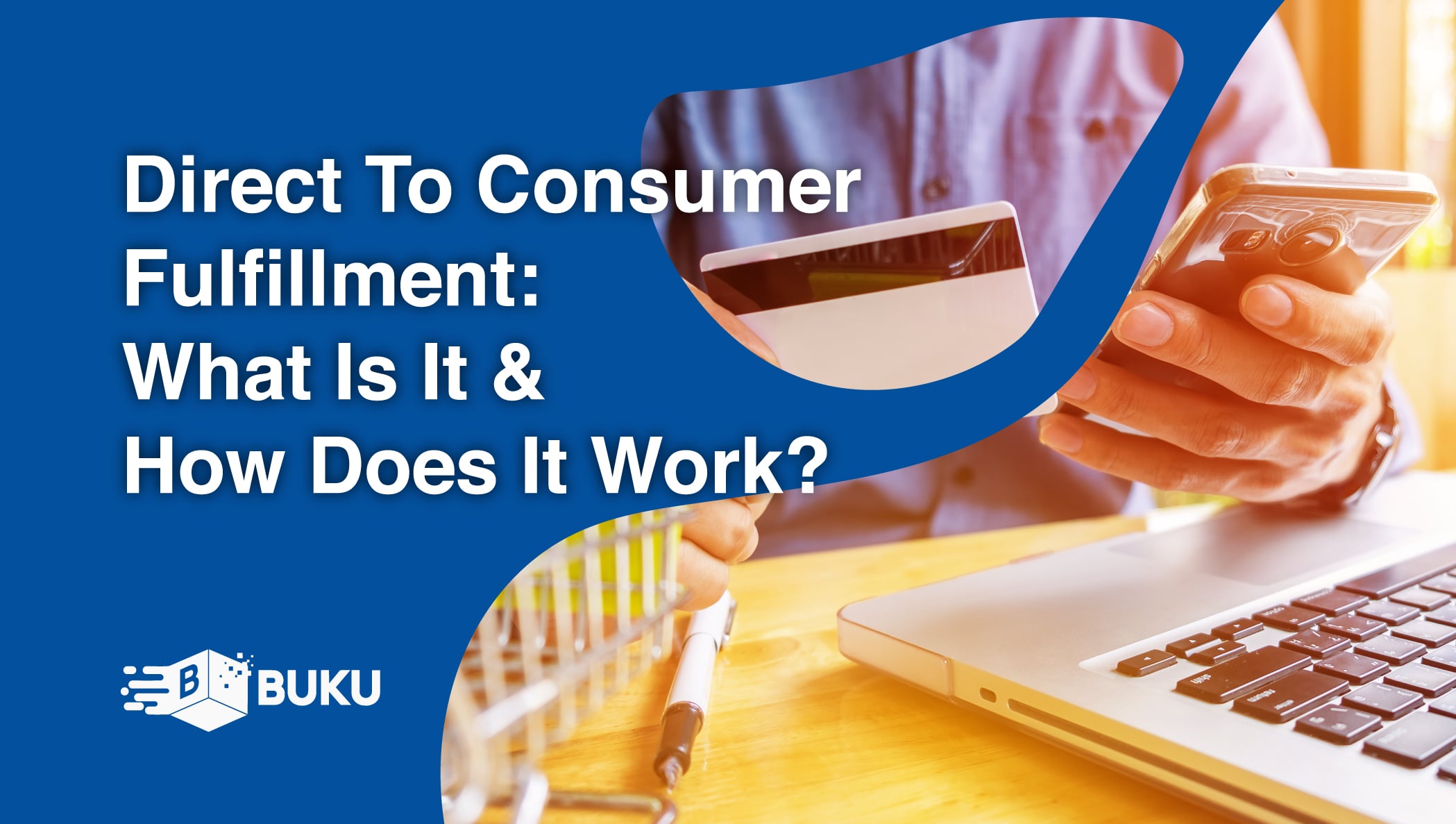
Direct-to-consumer (DTC) fulfillment is a strategy that helps brands sell and deliver their products directly to customers more efficiently while...